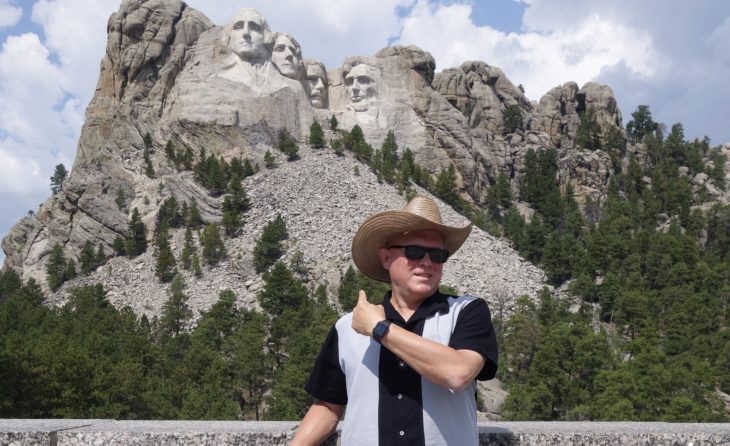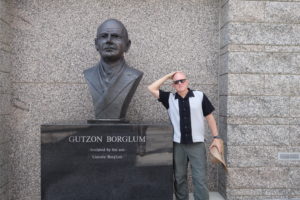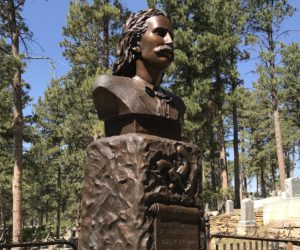
We’ve already sung the praises of eastern and central South Dakota. If you’ve read our previous posts, you know that we had a great time in Sioux Falls and the Badlands area. Well, I’m here to tell ya that the western part of the state is even better!
We spent three nights camping at Custer State Park in the Black Hills. And while the park was a perfect “base camp” for visiting must-see sites like Mount Rushmore and Deadwood, it turned out to be much more than just a place to sleep at night and stow our trailer while we explored during the day. In fact, Custer State Park provided some of our favorite experiences in the area. Within its boundaries we saw prairie dogs, pronghorn, feral donkeys, and a massive herd of bison. We drove scenic roads with pigtail bridges and narrow tunnels carved into rocky spires. We enjoyed late afternoon drinks on the patio and porch of scenic lodges. And we learned about gold-hunters squatting on Sioux Land, a politician with a knack for porkbarrel projects, and South Dakota’s first poet laureate.
Dead-center Location
We generally don’t spend a lot of time talking about the campgrounds we stay in. There are countless other websites that provide detailed reviews to help campers figure out where to stay. But I want to give a strong endorsement of the Stockade Lake South Campground in Custer State Park. We drove past (and, in some cases, through) several of the other campgrounds in the park, and Stockade South stands out as the nicest.Stockade Lake is at the far western end of the park, less than 10 minutes from the town of Custer with gas stations, grocery stores, restaurants, and more. And it’s in a very convenient spot to get to pretty much everything in the Black Hills. But Stockade South is also the most secluded campground in Custer State Park, on a peaceful loop road off the main drag with lots of trees and decent separation between sites. As the name implies, it’s next to a pretty lake that has lots of nice hiking trails around it.
With only 25 sites, it’s one of the smaller campgrounds and seems more geared to trailers and tents than to giant motorcoaches. We didn’t have the best site—we were next to the bathrooms—but that gave us a chance to meet a lot of neighbors! I hear that some of the other campgrounds get more wildlife, including herds of bison and elk, but we got our fill of that elsewhere in the park. When (not if) we come back, we’ll definitely stay at Stockade Lake again.
Dead Presidents
You really can’t visit this part of the country without seeing Mount Rushmore, even if you have complicated feelings about defacing (or, in this case, facing) a perfectly lovely mountain by chiseling the heads of rich old white guys into the granite. Any moral ambiguity you may feel will only strengthen as you learn more about the dude who carved the monument, Gutzon Borglum. It’s one of the great names of all time, rolling off the tongue in such a satisfying way that you can’t help saying it out loud every time you see it in writing, which you will on billboards all across South Dakota (I wish I’d kept score of the Borglum Museum signs vs. the Wall Drug ads). But other than that, old Gutzon sounds like kind of a jerk.Borglum was a bigwig in the Ku Klux Klan. He was a “dear friend” of Klan Grand Dragon and infamous rapist and murderer D.C. Stephenson. His last big gig before Rushmore was the huge memorial to Confederate heroes Lee, Davis, and Jackson at Stone Mountain in Georgia—at least until the United Daughters of the Confederacy fired him for being too difficult to work with.
(Brief sidetrack: we watched a ranger talk about Borglum while at Mount Rushmore, and the speaker did a really awful job of acknowledging the current controversy about Confederate monuments. She could have avoided the topic altogether. She could have touched on it as something that makes Borglum’s work more relevant right now. She could even have offered a bit of personal opinion—although that would probably get her fired by the current gang of idiots running the Park Service in Washington. Instead, what she did was defensively dismiss it as something that had nothing to do with Mount Rushmore and, somewhat angrily, warn her audience that she wasn’t going to answer any questions about that issue. Pretty weak sauce, if you ask me.)
Still, Mount Rushmore is an impressive site. From the first moment you spot it in the distance coming out of a tunnel on the Iron Mountain Highway, to the long walk straight at it along the corridor of flags, to your last glimpse of Washington’s profile as you drive away, it continues to deliver a jolt of surprise each time you see those huge stone faces. It’s also an impressive feat of artistic engineering, completed over 14 years in the harsh climate and rough terrain of the Black Hills, without a single fatality among the men dangling from the cliffs in leather harnesses with dynamite and jackhammers.
Deadwood
All I knew about the town of Deadwood was what I’d learned from the HBO show of the same name. And since that show was canceled after two seasons, there were a lot of holes in my knowledge. We filled in some of those gaps with a self-guided walking tour of the town on our second day in the Black Hills.
It’s a place that continues to trade on its lawless past, with casinos and bars all up and down Main Street and a colorful crowd—more bikers than gunslingers now—that radiates a slightly malevolent energy. I certainly didn’t feel unsafe in Deadwood, but I was never entirely at ease either. It’s the kind of town where you want a seat in the corner with the wall at your back (although even that didn’t help Wild Bill Hickok much).
Speaking of Wild Bill, our first stop in town was Mount Moriah Cemetary where he is buried next to Calamity Jane. People still leave tributes (nips of Jack Daniels, playing cards, etc.) on their graves. After that, we explored the town a bit before grabbing burgers at a place with outdoor tables. The only member of our party who seemed at risk of starting a brawl was Zora, who kept a wary eye on the Weimaraners two tables over. Lunch ended without incident, and we got out of town before the Weimaraner Gang could pick up our trail.And then we headed west, into the sunset (metaphorically speaking, at least—the sun was actually at our backs since we decamped in the morning). Our next stop was outside of Cheyenne, Wyoming, at a gorgeous state park named after famous announcer Curt Gowdy, who suffered through covering the Red Sox in the 1950s and 1960s while they were consistently among the worst and least interesting teams in baseball. Much as his period in Boston was just one stop in Gowdy’s storied broadcasting career, the park named for him was just a brief overnight on our way to Denver. But that’s a story for another day…



Sounds like if Borglum was alive today, he’d be eager to add our current President to his monument. Glad the trip continues to go so well and that you’re finding the time to keep us posted.
Im really enjoying reading about your trips and seeing it thru your eyes. My husband & I always wanted to do what you’re doing, it just didn’t happen.
I love how Zora is such a big part of your trip. Never been to the Dakotas so it’s that much mor enjoyable!
Hug Zora for me!